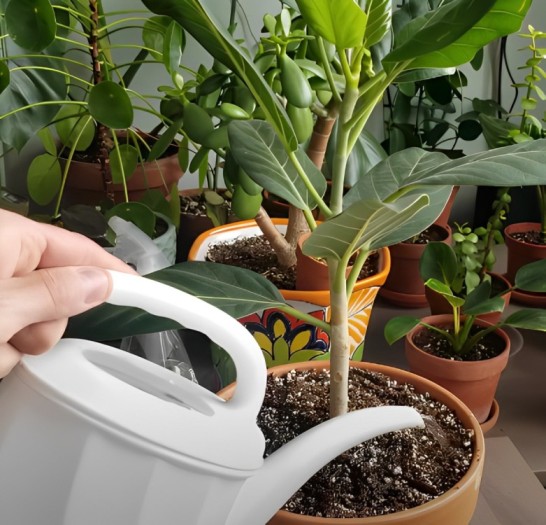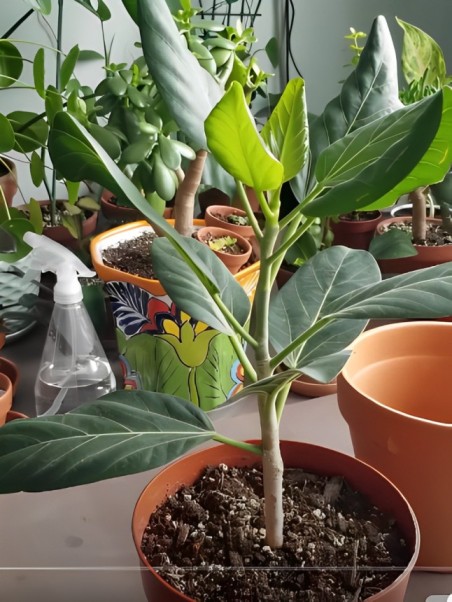Ficus Audrey Care, Propagation and Problems (2023)
Ficus Audrey, scientifically called Ficus benghalensis Audrey. It is visually placed as an indoor plant. It is native to India and Southeast Asia. If we talk about growth habit, it’s a tree-like growth habit. It can reach heights of 2-10 feet and large, glossy, oval to elliptical leaves that can grow up to 12 inches in size.

This plant is placed in bright, indirect sunlight and requires high humidity levels, making it an ideal addition to homes with suitable environmental conditions. It also purifies the air.
To ensure its well-being, maintain moist but not waterlogged soil, fertilize monthly during the growing season, and be careful of potential pests like scale and mealybugs.
While Ficus Audrey is relatively low-maintenance because it cannot take hight quality of maintenance. Its toxic nature to pets, including cats and dogs, should be noted, making it important to keep it out of their reach. Ficus andrey live both outside and inside of the home with proper caring.
| Common name | Banyan Tree, Ficus-Audrey |
| Scientific Name | Ficus benghalensis |
| Family | Moraceae |
| Distribution | India, Southeast Asia |
| Plant type | Evergreen, indoor tree |
| Size | Up to 6-10 feet indoors |
| Leaf Colour | Dark green with prominent veins |
| Leave | Glossy, large, violin-shaped leaves |
| Temprature | 65-75°F or 18-24°C |
| Humidity | 40-60% relative humidity |
| Propagations | Stem cuttings or air layering |
| Light requirement | Bright, indirect sunlight |
| Soil requirement | Well-draining potting mix |
| Watering Need | Allow the top inch of soil to dry before watering, avoid overwatering |
| Pests | Spider mites, mealybugs, and scale insects |
| Toxicity | Toxic to pets and humans if ingested |
| Uses | Air-purifying qualities, impressive size, and presence |

Contents
- 1 Top Care Tips
- 2 Care For Ficus Audrey
- 3 Ficus Audrey Propagation
- 4 Pruning Requirement
- 5 Potting and Repotting Ficus Audre
- 6 Common Pests
- 7 Pets
- 8 They’re the same as the Banyan Tree
- 9 Toxicity
- 10 Common Health Problems and solutions
- 11 Ficus-Audrey Care Guide: Tips for Healthy Growth and Pet Safety
- 12 Propagation, Maintenance, and Common Concerns: A Comprehensive Ficus-Audrey Care Manual
- 13 FAQs
Top Care Tips
- Light: Put it in a spot with lots of bright, but not direct sunlight.
- Temperature: Keep it up between 65-75°F (18-24°C) all day.
- Humidity: It likes humidity, so use a humidifier or spray water.
- Water: Water it when the top inch of soil is dry, and don’t suck it.
- Pot: Repot it every 2-3 years in a slightly bigger pot.
- Food: Feed the plant food in spring and summer but not do it in winter.
- Trim: Cut off dead leaves and trim leggy parts.
- Pests: See out for bugs and treat them if you see any.
- Support: Use sticks or anything else to help it stand tall as it grows.
- Winter Break: It can take up water and slow down in winter, so don’t give water and feed more.
- Keep Away from Pets: Don’t let your pets nibble on it; it’s not safe for them.
- Watch for Changes: If it looks unhealthy, adjust it more how you care for it. Droopy leaves might mean it need something different.
Care For Ficus Audrey

Light Requirements
Ficus-Audrey doesn’t require much light, making it a low-maintenance plant. Put it somewhere where it receives lots of bright, indirect light to keep it content. Imagine a bright space where the sun doesn’t directly hit the plant.
Although it can tolerate some sunshine, too much of it might damage its leaves. Remember, to keep your Ficus-Audrey healthy, locate the “just right” place with decent, but not excessive, light.
Water Requirement
The health of your Ficus plant depends on meeting its water requirements. Between waterings, these plants want their soil to somewhat dry out. If the soil feels dry after inserting your finger about an inch into it, it’s time to water.

Make sure the water you add is sufficient to cause water to begin dripping from the pot’s drainage holes. But keep in mind that your Ficus plant does not like moist roots, so avoid letting it sit in water. Your Ficus plant will remain content and flourish if you consistently water it and let the soil partially dry up.
Soil Requirement
Simple soil requirements apply to Ficus-Audrey. It prefers soil that drains properly, so water should quickly pass through it and not pool there. Use potting soil designed for indoor plants or create your own by adding perlite or sand to conventional potting soil to make it lighter.
In order to maintain the health of your Ficus plant roots, it is important to aid in the airflow and drainage of water. Remember, moist soil might cause issues, so wait until the top inch (about 2.5 cm) has dried off before watering it again.

Humidity And Temperature Requirement
It’s not too difficult to take care of your Ficus-Audrey as long as you pay attention to its requirements for temperature and humidity. The ideal temperature range for this plant is between 65 and 75 degrees Fahrenheit (18 and 24 degrees Celsius).
To keep it content, keep it free from draughts and abrupt temperature fluctuations. This plant likes moisture, hence she is a fan of humidity. By using a humidifier or sometimes misting water over it, you may make it feel at home.
This keeps the leaves from becoming too dry and crispy. Therefore, bear in mind that your Ficus-Audrey will flourish if you maintain a comfortable temperature and provide it with some humidity.
Fertilizer Requirement
When you adhere to your Ficus plant fertilizer needs, maintenance is an easy. During its growth season, which is often in the spring and summer, this plant enjoys a satisfying feed. Consider it as feeding time for your plant friend.
A balanced liquid fertilizer may be applied every four to six weeks throughout these months to give it a boost. But here’s the thing during the winter, your plant takes a little holiday, allowing you to cut back on feeding.
Just keep in mind that your Ficus plant will repay you with lush, green leaves if you feed it when it’s hungry during the active growing season.
Also, make sure to check out our in-depth monkey cup plant care guide.
Ficus Audrey Propagation

One of the easiest ways to do it is through Stem cuttings. Here’s how:
- Pick a good stem with a few leaves to use as a cutting. Just below a leaf node, which is where a leaf is connected to the stem, make the cut. Make a small slant in the cut.
- Get a small pot and fill it with a mixture of soil and perlite or vermiculite as your rooting medium. They aid with drainage. Insert the cutting into the ground approximately an inch deep.
- Keep It Humid: To make a little greenhouse, cover the pot with a plastic bag or a dome. This maintains a high level of humidity, which is excellent for root development.
- Place the pot in an area with indirect light that is bright and warm. Keep it warm, between 70 and 75 degrees Fahrenheit (21 and 24 degrees Celsius).
- Water the cutting just enough to keep the ground moist but not soaked. Avoid overwatering as it might lead to decay.
- Be patient; root growth might take a few weeks to a few months. When new leaves begin to emerge, you’ll know it’s ripe.
- Transplant: You may move your cutting into a larger pot with potting soil once its roots have developed and it has gotten a little bigger.
- Air Layering:
- Pick off a piece of the stem, make a quick incision, and peel the bark back.
- Wrap the exposed region in damp sphagnum moss and apply rooting hormone (optional).
- Put plastic wrap over the moss to hold it in place.
- Cut the rooted piece from the parent plant after roots have formed, and then plant it in a separate container.
- Leaf Cuttings:
- Cut a leaf that is in good health into pieces.
- Place these leaf fragments in a potting soil that drains properly.
- Till new plants emerge from the leaf parts, keep the soil wet but not soggy and give it the necessary attention.
- Division:
- You can divide your Ficus plant during repotting if it has several stems or has become a cluster.
- Plant the individual stems or bunches in their own pots after carefully separating them.
- Root Cuttings:
- Cut healthy root sections into pieces such that each piece has at least one node.
- Put these root segments in a container with a soil that drains properly.
- Up until new shoots appear, maintain careful care.

Pruning Requirement
Giving your Ficus-Audrey a little trim to keep it looking its best involves pruning. To promote a bushier, fuller form, you can prune back any lanky growth and remove any dead or yellowing leaves.
Just be sure to trim just above a leaf node, which is where a leaf joins to the stem, using clean, sharp scissors or pruning shears. During the spring and summer growing seasons, it’s a good idea to prune, but don’t go crazy; a small amount of pruning here and there can assist your plant thrive and stay healthy.
Potting and Repotting Ficus Audre
It’s important to get the appropriate-sized pot and understand when to do it when it comes to potting and repotting your Ficus-Audrey. To allow for growth, start with a pot that is just a little bit bigger than the existing one.
Every two to three years, when your plant outgrows its container, repotting is usually necessary. Roots poking through drainage holes or a crowded appearance of the plant are indicators that it is time.
When repotting your Ficus plant, carefully shake off part of the old dirt, remove any damaged roots, and then plant it in its new location with new, well-draining potting soil. This promotes the health and growth of your plant.
Common Pests
Like many other plants, this type of planty is susceptible to common pests. Mealybugs and spider mites are two common nuisances. Mealybugs are tiny, cottony lumps that resemble ants, while spider mites are even smaller and spin delicate webs.
Your plant’s leaves become yellow and get weaker as a result of their sucking sap. Check your Ficus-Audrey often for these pests, and if you find any, treat them with insecticidal soap or neem oil to prevent damage to your plant.
Pets
The Ficus plant is a well-liked houseplant, but it’s important to be aware that if consumed, it can hurt cats dogs, and other furry animals. If pets nibble on the leaves of this plant, it contains compounds that might result in nausea, drooling, and even more serious symptoms.
It’s a good idea to keep your plant out of your pets’ reach in order to keep them safe. While it may be lovely to humans, it is essential to prevent our pets from snacking on it in order to prevent any health problems.
They’re the same as the Banyan Tree
Ficus-Audrey, sometimes known as the “Bengal Fig,” may make you think of the illustrious Banyan tree. They both belong to the genus Ficus and have similar growth patterns. Ficus plant like Banyans, has remarkable aerial roots that extend downward, giving it a distinctive and exotic look. They might not get as big as Banyans indoors, but they still have the same grandeur, which makes them an alluring addition to an indoor garden.
Toxicity
If consumed, this plant may be harmful to both people and animals. When touched or eaten, its leaves and sap contain ingredients that might upset the stomach, irritate the skin, or induce allergic responses. To safeguard the safety of curious pets and kids, it is essential to keep this plant out of their reach.
In the event of accidental consumption, seek emergency medical treatment. If you have a Ficus-Audrey, enjoy it, but be aware of its possible toxicity.
Common Health Problems and solutions
Ficus plant is a resilient plant, but it can encounter some common health issues. Here are a few problems and simple solutions:
Yellowing Leaves:
- Problem: Yellow leaves may indicate overwatering or too little light.
- Solution: Change the time you water, making sure the top inch of soil is dry before you do. Transfer the plant to a location with more light and indirect sunshine.
Dropping Leaves:
- Problem: Stress brought on by temperature fluctuations or draughts may result in unexpected leaf fall.
- Solution: Keep your Ficus-Audrey away from draughts and in a steady, warm atmosphere.
- Pests (like Mealybugs or Spider Mites):
- Problem: By suckling on your plant’s fluids, these bugs can cause damage.
- Solution: Use insecticidal soap or neem oil to get rid of infestations. To stop the pests from spreading, isolate the plant.
- Fungal Issues (like Leaf Spot):
- Problem: Fungal infections can be the source of dark patches on leaves.
- Solution: Enhance airflow, refrain from sprinkling water on the leaves, and get rid of any damaged foliage. If the issue continues, think about using a fungicide.
Ficus-Audrey Care Guide: Tips for Healthy Growth and Pet Safety
Ficus-Audrey, a popular houseplant, raises questions about its care and potential hazards to pets. It’s essential to note that Ficus plant is indeed toxic to dogs and cats if ingested, so pet owners should exercise caution. To ensure the well-being of your furry friends, keep the plant out of their reach or consider choosing non-toxic alternatives. When it comes to care, providing the right conditions is crucial.
This plant thrives in bright, indirect sunlight and well-draining soil, making it essential to use the best soil for this type of plant and fertilize it regularly during the growing season. Maintaining proper humidity levels can prevent issues like brown tips and curling
leaves, as this plant does appreciate a bit of moisture in the air. Overwatering should be avoided as it can lead to root rot, but underwatering can hinder growth.
To shape and encourage a bushy appearance, trimming and pruning are recommended, as well as cleaning leaves to allow for better light absorption. If your plant isn’t growing or shows signs of distress, consider addressing factors like light exposure, watering frequency, and soil quality to help revive it.
Propagation, Maintenance, and Common Concerns: A Comprehensive Ficus-Audrey Care Manual
For those interested in expanding their Ficus plant collection or sharing this beautiful plant with friends, propagation is an excellent option. You can propagate this plant through stem cuttings or leaf cuttings. Leaf propagation is possible, but it can be more challenging than stem propagation.
To propagate successfully, take healthy cuttings, and ensure they have nodes. Place them in water or soil, keep them in a warm, humid environment, and monitor their progress. While Ficus Audrey is primarily an indoor plant, it can sometimes thrive outdoors if you live in a suitable climate.
However, make sure to gradually acclimate it to outdoor conditions to prevent shock. Lastly, for optimal growth, Ficus-Audrey requires consistent care, including the right balance of light, water, and nutrients.
FAQs
How do you care for Audrey Ficus?
The Audrey will thrive in an area with lots of bright, indirect light, just like other Ficus plants.
Is a Ficus Audrey a good indoor plant?
This plant is a lovely interior tree that works best in filtered light conditions.
Does Ficus Audrey need direct sunlight?
Yes it likes a location that will receive abundant bright, indirect light or sunshine.
Is Ficus Audrey a Banyan Tree?
yes this plant is also called as a Banyan Tree.
Does ficus Audrey need water?
Throughout the growing season, once every week, and once every other week during the winter.
What is the best fertilizer for Audrey Ficus?
Fiddle Leaf Fig Food is the best fertilizer for ficus-audrey.
Can I put my Ficus Audrey outside?
It loves to be outside in the shade and will put on considerable growth – 1-2 feet is possible.






